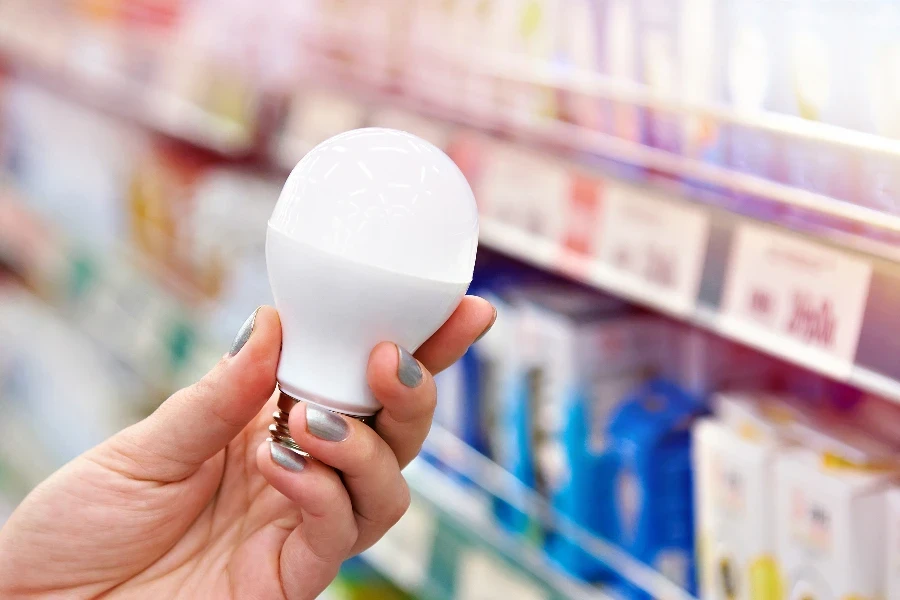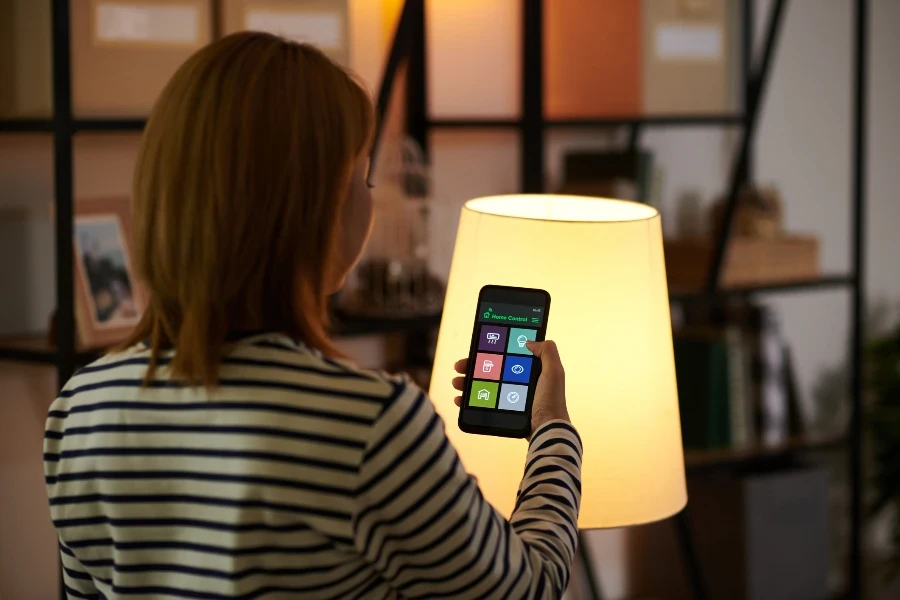Light bulbs have evolved tremendously over the years. From simple incandescent and halogen bulbs to energy-efficient fluorescent light bulbs, not to mention smart light bulbs that individuals can control using their smartphones, tablets, or other smart devices.
But with all their advanced features, what do consumers look for when shopping for smart light bulbs? In this guide, we’ll explore the key factors to consider when selecting smart LED light bulbs for your inventory in 2024.
Table of Contents
Smart LED light bulbs: Are they the right investment?
Factors to consider when selecting smart LED light bulbs
Capitalize on the growing smart bulb demand
Smart LED light bulbs: Are they the right investment?
People are increasingly embracing smart bulbs because they’re more energy-efficient and durable than traditional incandescent bulbs. Compared to incandescent bulbs, LED light bulbs use up to 90% less energy and last up to 25 times longer.
As a result of these benefits and the rising popularity of smart homes, the global smart lighting market is expected to grow at a compound annual growth rate (CAGR) of 22.1% between 2023 and 2030.
Currently, the global LED lighting market is valued at roughly US$ 17.86 billion and is expected to reach US$ 72.35 billion by 2030, making LED light bulbs a worthwhile investment for businesses looking to fulfill the growing demand for them.
Factors to consider when selecting smart LED light bulbs
Smart LED bulbs aren’t created equal. There are many bulbs, each offering something different, and shoppers may favor one bulb type over another. Here are key things to consider when choosing smart LED light bulbs.
Brightness
Smart bulb manufacturers measure the brightness of light bulbs in lumens. Lumens is a more accurate way of measuring the brightness of a bulb than the traditional measure of watts, which indicates how much energy a bulb consumes rather than its brightness.
Generally, the ideal lumens required for a room will depend on the room size, wall colors, and lighting preferences. As a general guideline, here’s the ideal lumens range for different rooms in a home:
- Living rooms: 1,500 to 3,000 lumens
- Bedrooms: 2,000 to 4,000 lumens
- Dining rooms: 3,000 to 6,000 lumens
- Bathrooms: 4,000 to 8,000 lumens
- Kitchens: 5,000 to 10,000 lumens
However, it’s worth noting that these are ballpark figures. The best way to determine the appropriate lumens range for a room is to use an online lighting calculator. That said, bathrooms and kitchens typically require brighter lighting, while living rooms and bedrooms are usually less bright.
Color temperature
Color temperature is measured in Kelvin (K), and it refers to the warmness or coolness of a light bulb. Bulbs at the low end of the Kelvin spectrum (usually 2,500K and below) produce a warm orange or yellowish glow akin to incandescent bulbs. Conversely, light bulbs at the high end of the Kelvin spectrum (5,000K and above) produce a colder bluish-white light, similar to natural daylight.

Generally, warmer color temperatures are ideal for relaxing spots in the home, like living rooms and bedrooms. On the other hand, cooler color temperatures are better suited for work-oriented areas like kitchens, study rooms, and home offices.
Look for smart LED light bulbs with a wide color temperature range to cater to the needs of different customers.
Color rendering index
A smart bulb’s color rendering index (CRI) rating indicates how accurately it can illuminate colors. The CRI scale ranges from 0 to 100, with a higher CRI rating denoting better light quality. Smart bulbs with CRI values above 90 are considered excellent, while those below 80 are usually deemed substandard.

Customers working in color-sensitive settings such as art studios, home offices, or commercial spaces are certain to want smart LED light bulbs with high CRI values.
Bulb shape
Smart LED light bulbs come in various shapes designed for different applications. Some bulbs are ideal for ambient lighting, while others are better suited for task lighting.
When choosing smart bulbs based on shape, it’s important to remember there are two types of light beam angles: directional and omnidirectional. Directional light is focused in a particular direction, while omnidirectional light is spread across a wide area.

Bulb shapes like reflectors, and GU10 typically offer directional lighting, making them ideal for task, pendant, and recessed lighting. On the other hand, globe and golf-shaped light bulbs typically provide omnidirectional light, making them better suited for general lighting.
Dimmer compatibility
Dimmable smart light bulbs are ideal for changing the ambiance in a room to create different moods. This quality makes dimmable lights ideal for individuals who want a multipurpose light for various tasks.
While most smart LED light bulbs are dimmable, others aren’t. Check the product description or the specification sheet provided by the bulb manufacturer to determine whether the light bulb is compatible with dimmers, as some customers may consider dimmer incompatibility a deal-breaker.
Connectivity
Many smart bulbs support connectivity via Wi-Fi and Bluetooth, while others support connectivity via ZigBee — a wireless technology that enables low-power devices to communicate with each other. Some brands also support connectivity via all three technologies.

Look for bulbs that offer a variety of connectivity options, as they offer more flexibility and can facilitate remote operation.
Also, look for brands compatible with various home assistants like Google Assistant, Amazon Alexa, and Apple HomeKit, as they offer greater control using voice commands.
Hub requirement
Some smart bulbs require a smart home automation hub to operate. A smart home automation hub is a central point for controlling all the devices connected to a home automation system.
While smart home hubs offer benefits like the ability to control multiple smart devices from a single app, smart bulbs dependent on hubs usually cost more and take longer to install, so they aren’t ideal for consumers looking for affordable lighting solutions.
Advanced features
Unlike their predecessors, LED light bulbs come with many sophisticated features. Here are some key advanced features consumers look for when shopping for smart bulbs:
- Scheduling: Many smart bulbs allow individuals to create schedules to turn lights on or off at particular times.
- Geofencing: Some smart bulbs can use the GPS location of a smart device like a smartphone or tablet to determine when to turn lights on or off.
- Multiple colors: While many smart LED light bulbs are white, others can mimic other colors. For consumers who want to create different moods for different occasions, consider stocking color-changing LED light bulbs.
Lifespan
Smart LED light bulbs have an exceptional average lifespan of nearly six years. However, LED light bulbs aren’t all the same. Some offer longer lifespans, with some bulbs boasting lifespans of over 20 years.
Long-lasting LED smart bulbs will appeal to customers tired of constantly replacing blown-out incandescent bulbs and want to reduce the need for frequent replacements.
Warranty
While light bulbs can last for eons, they come with warranties like other smart devices. Most manufacturers usually offer a standard one-year warranty, but some offer extended ones. Some manufacturers also offer comprehensive warranties, including maintenance, while others only offer a replacement warranty.
Check the manufacturer’s warranty policy or consult the supplier to avoid financial losses in case of a product defect.
Capitalize on the growing smart bulb demand
Many consumers worldwide are ditching power-hungry incandescent light bulbs and replacing them with long-lasting, energy-efficient, eco-friendly LED light bulbs to lower their electricity bills and embrace smart living.
Want to fulfill the growing demand for LED light bulbs? Check out Chovm.com for a wide range of smart LED light bulbs.





 বাংলা
বাংলা Nederlands
Nederlands English
English Français
Français Deutsch
Deutsch हिन्दी
हिन्दी Bahasa Indonesia
Bahasa Indonesia Italiano
Italiano 日本語
日本語 한국어
한국어 Bahasa Melayu
Bahasa Melayu മലയാളം
മലയാളം پښتو
پښتو فارسی
فارسی Polski
Polski Português
Português Русский
Русский Español
Español Kiswahili
Kiswahili ไทย
ไทย Türkçe
Türkçe اردو
اردو Tiếng Việt
Tiếng Việt isiXhosa
isiXhosa Zulu
Zulu